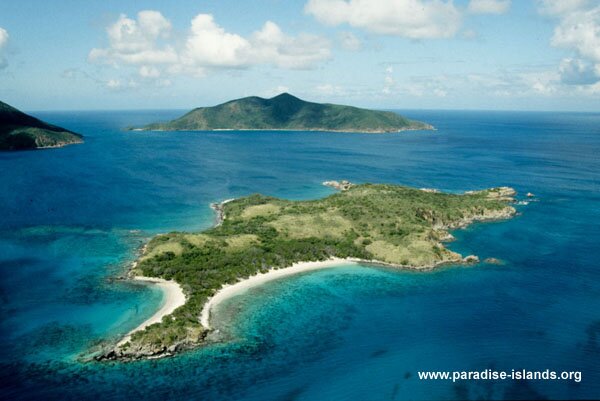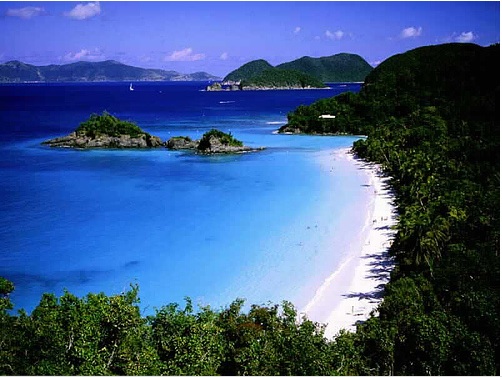Although there was some evidence of inhabitants on St. John as early as 1100, no lasting settlements existed until the Danish took possession of St. John in 1694. They established the first permanent European settlement near Coral Bay, attracted by the lucrative prospects of cultivating sugar cane.
By 1733, there were 109 cane and cotton plantations covering the island. As the plantation economy grew, so did the demand for slaves, who were essential to sugar production. Under the auspices of the Danish West India Company, St. Thomas became the center of the slave trade with Africa. But the slaves soon revolted, killing all the whites on the island in 1733. French troops from Martinique, not Danish troops, subdued the slaves.
Sugar production continued for more than a century, effectively ending with the emancipation of the slaves in 1848. The United States purchased the Virgin Islands from Denmark in 1917. Bay rum production, cattle and subsistence farming were the main occupations until tourism discovered St. John in the 1930s.
Word of the untouched paradise on St. John spread in the 1930s, and in 1956 the Rockefeller interests bought land and gave it to the Federal Government for a national park, forming the Virgin IslandsNational Park. More than half of the land on St. John lies within the park boundaries. The rest is small towns, shops, homes and private lands. In 1962, the park was enlarged to include 5,650 acres of submerged lands off the island. The Virgin Islands Coral Reef National Monument was proclaimed in 2001 that includes 12,708 acres of federally owned submerged lands off the island.

Of the 60 mostly uninhabited islands that make up the US Virgin Islands, the biggest and most visited are St Thomas, St John and St Croix. Their appeal lies in the amalgamation of the exotic and the recognizable, an island paradise with modern comforts, and a balance between Caribbean culture and American practicality.
The energetic capital of Charlotte Amalie, with its attractive harbor, lies on St Thomas. This island is the most Americanized of the chain, famous for its world-class duty-free shopping. Nearby St John is an unspoilt nature lover's paradise, with most of its forests, pristine beaches and reefs part of a protected national park. The largest of the islands is St Croix and its remoteness from the others, the historic remnants scattered about the landscape, the pretty Danish-influenced towns of Frederiksted and Christiansted, and the snorkeling at nearby Buck Island are the attractions here.
Surrounded by the crystal-clear waters of the Caribbean, these islands boast some of the most splendid coastline in the world, with white sandy beaches, astonishing coral reefs and pristine marine life, secluded coves, and untouched rainforests rising up above the sea-swept landscape. Caribbean color touches every aspect of the islands, blending with the strong Danish influence in the towns. White sails glide effortlessly across the emerald waters; local craftsmen display their unique island art along cobblestone alleyways; tiled villa roofs provide a splash of red against the verdant hillside; busy markets supply the essentials for a delicious cuisine; and the sounds of folk songs and calypso bands fill the air.
The Virgin Islands being among the most popular cruise ship destinations in the Caribbean has meant that the port towns of Charlotte Amalie, Christiansted and Frederiksted are usually swamped with newly arrived passengers in a frenzy of shopping and dining. Main beaches are seldom deserted, and the key reef areas are often a flurry of flippers and snorkels. Luxury resorts and fine hotels share the streets with old colonial architecture. Yet it is still possible to escape the crowds and find that bit of elusive paradise, to relax away from the divers and sailors, the sightseers, the ecological tour groups, and the shoppers.
By 1733, there were 109 cane and cotton plantations covering the island. As the plantation economy grew, so did the demand for slaves, who were essential to sugar production. Under the auspices of the Danish West India Company, St. Thomas became the center of the slave trade with Africa. But the slaves soon revolted, killing all the whites on the island in 1733. French troops from Martinique, not Danish troops, subdued the slaves.
Sugar production continued for more than a century, effectively ending with the emancipation of the slaves in 1848. The United States purchased the Virgin Islands from Denmark in 1917. Bay rum production, cattle and subsistence farming were the main occupations until tourism discovered St. John in the 1930s.
Word of the untouched paradise on St. John spread in the 1930s, and in 1956 the Rockefeller interests bought land and gave it to the Federal Government for a national park, forming the Virgin IslandsNational Park. More than half of the land on St. John lies within the park boundaries. The rest is small towns, shops, homes and private lands. In 1962, the park was enlarged to include 5,650 acres of submerged lands off the island. The Virgin Islands Coral Reef National Monument was proclaimed in 2001 that includes 12,708 acres of federally owned submerged lands off the island.

Of the 60 mostly uninhabited islands that make up the US Virgin Islands, the biggest and most visited are St Thomas, St John and St Croix. Their appeal lies in the amalgamation of the exotic and the recognizable, an island paradise with modern comforts, and a balance between Caribbean culture and American practicality.
The energetic capital of Charlotte Amalie, with its attractive harbor, lies on St Thomas. This island is the most Americanized of the chain, famous for its world-class duty-free shopping. Nearby St John is an unspoilt nature lover's paradise, with most of its forests, pristine beaches and reefs part of a protected national park. The largest of the islands is St Croix and its remoteness from the others, the historic remnants scattered about the landscape, the pretty Danish-influenced towns of Frederiksted and Christiansted, and the snorkeling at nearby Buck Island are the attractions here.
Surrounded by the crystal-clear waters of the Caribbean, these islands boast some of the most splendid coastline in the world, with white sandy beaches, astonishing coral reefs and pristine marine life, secluded coves, and untouched rainforests rising up above the sea-swept landscape. Caribbean color touches every aspect of the islands, blending with the strong Danish influence in the towns. White sails glide effortlessly across the emerald waters; local craftsmen display their unique island art along cobblestone alleyways; tiled villa roofs provide a splash of red against the verdant hillside; busy markets supply the essentials for a delicious cuisine; and the sounds of folk songs and calypso bands fill the air.
The Virgin Islands being among the most popular cruise ship destinations in the Caribbean has meant that the port towns of Charlotte Amalie, Christiansted and Frederiksted are usually swamped with newly arrived passengers in a frenzy of shopping and dining. Main beaches are seldom deserted, and the key reef areas are often a flurry of flippers and snorkels. Luxury resorts and fine hotels share the streets with old colonial architecture. Yet it is still possible to escape the crowds and find that bit of elusive paradise, to relax away from the divers and sailors, the sightseers, the ecological tour groups, and the shoppers.
Throughout history, people seeking paradise on Earth have traveled, or dreamed of traveling, to a tropical island where they could find beauty, refreshment, and refuge. Among the earthly delights of the Virgin Islands National Park are tropical forests, wildlife, wildflowers, and breathtaking views. Just offshore, dazzling natural riches are preserved within the park's marine areas. Combined, the land and waters of St John are in many ways a world apart. The island's remarkable variety of over 800 species of plants includes the teyer palm, which is St John's only native palm tree; the bay rum tree, whose aromatic leaves once provided the oil for the world-famous bay rum cologne; and rare, brilliant colored wild orchids. St John is a sanctuary for animals as diverse as corals, sea turtles, and reef fish, insect-and-fish eating bats; frogs; gecko, anole, and iguana lizards; and of course birds. More than 30 species of tropical birds breed on the island. They include the bananaquit, the black, parrot-like smooth-billed ani, and two species of Caribbean hummingbirds. Many warblers and other birds seen in continental United States in the summer spend their winters in the dense forests. The white sand beaches of the Virgin Islands have a well-deserved reputation for being among the most beautiful beaches in the world. Picture-postcard beaches fringe Hawksnest Bay, Trunk Bay, Cinnamon Bay, Saltpond Bay and many of St John's other sheltered coves. The coral reef is home for an extensive variety of animals. These include colorful members of the grouper family, parrot fish, tangs, grunts, snappers, butterfly fish, angles, damsels, squirrel fish, and wasses. The reef is also represented by invertebrates such as sponges, starfish, urchins, worms, crabs, lobsters and anemones. Reefs have been compared to underwater cities. Alleys, streets and cul-de-sacs twist between high-rise coralline structures where vacant dwellers are virtually nonexistent. Wispy cleaner shrimps dance about to attract their more-than willing finned hosts. Moray eels, spiny lobsters, deflated porcupinefish, and crimson squirrelfish spend their days holed up in reef crevices. At night, the city is transformed into an eerie nether world where octopuses slither about and parrotfish seek protection resting in their veil-like mucus cocoons. Coral polyps emerge from stony skeletal homes, stretching their tentacles out to feast on plankton. Throughout both day and night, lacy-looking sea fans, sea whips, sea plumes, and other soft corals undulate in the current. At night, coral animals such as star coral, brain coral, pillar coral, and others extend their tentacles to feed and may be seen by observers. Take the 15 mile tour by taxi or car rental over the Centerline Road and back via the North Shore Road reveals spectacular scenery. Underwater Tour at Trunk Bay. There's a self guided trail underwater with etched glass plates ten feet under. Explore the wonders of corals and their occupants. Annaberg Ruins has beautiful scenery and partially restored ruins of slave-run Annaberg sugar mill.


































 7:18 AM
7:18 AM
 crkota
crkota











 Posted in:
Posted in: 

0 comments:
Post a Comment